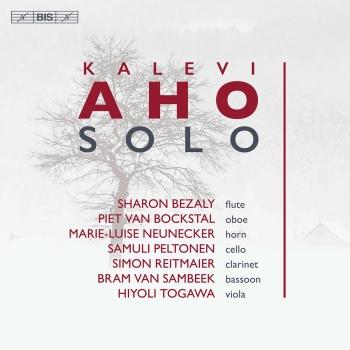Various Artists - Kalevi Aho
Biography Various Artists - Kalevi Aho
Kalevi Aho
one of Finland’s leading composers of today, was born in Forssa in southern Finland on 9th March 1949. He studied at the Sibelius Academy in Helsinki under Einojuhani Rautavaara and in West Berlin in Boris Blacher’s composition class. In the years 1974-1988 he was a lecturer in musicology at Helsinki University; from 1988 until 1993 he was professor of composition at the Sibelius Academy and since the autumn of 1993 he has been a freelance composer.
In the works which marked his breakthrough (the First Symphony, 1969, and Third String Quartet, 1971) Aho continues in the tradition of Shostakovich; even in these pieces, however, he arrived at a very original formal/dramatic decision. Thus, in the four-movement First Symphony, we are gradually drawn ever further away from the “existing reality” of the beginning, ultimately reaching the third movement’s strange, pseudo-baroque style, and finally, in the last movement, we can meet the problems of the “true reality” head on. The structural starting-point for the single-movement Second Symphony (1970/95) is a triple fugue. In the four-movement Third Symphony (1971-73) the dramatic tension is different; it is a conflict between an individual (a solo violin) and the sound blocks of the orchestra; there is a similar conflict in the pessimistic Cello Concerto (1983-84). The culmination of Aho’s first period (approx. 1969-74) is the three-movement Fourth Symphony (1972-73) with videly varied emotional contrasts.
The Fifth Symphony (1975-76) marks a turning point in Aho’s output. From a structural point of view this massive work is extremely complicated; in this multi-layered symphony, instead of polyphony between various individual instrumental voices, we hear a polyphony of different, independent musical strands. The virtuoso and colourful Sixth Symphony (1979-80) concludes a sequential line of development in Aho’s symphonic work; after this, the composer concentrated for a while on concertos and operas.
Aho’s first opera, Avain (The Key, 1978, with a libretto by Juha Mannerkorpi) tells of the paranoid alienation of an inhabitant of a big modern city in the estranging social climate of today. In 1982 and 1984 The Key was also performed by the Hamburg State Opera. In the years 1985-87 Aho wrote his sharply satirical second opera Hyönteiselämää (Insect Life), which combines elements both of comedy and of tragedy (the libretto, by the composer himself, is based on a play of the same name by Josef and Karel Capek) and contains numerous stylistic parodies as well as pointed social criticism. The work was premiered with great success by the Finnish National Opera on 27 September 1996. Drawing on material from the Insect Life, Aho composed his Seventh Symphony in 1988: a six-movement, cheerful work, the “Insect Symphony” has been described as a post-modern, tragicomic anti-symphony. Two years later Aho composed Pergamon for four narrators, four orchestral groups and organ; the text, which is in four languages, is based on Peter Weiss’s novel Die Ästhetik des Widerstands. In the intense Chamber Symphony No. 2 for strings (1991-92) we hear, in a sense, the music of the composer’s inner voices.
In 1992 the Lahti Symphony Orchestra appointed Aho as its composer in residence, and he has written all of his more recent orchestral works for these musicians. The bright, single-movement Symphony No. 8 (1993) for organ and orchestra is Aho’s most expansive instrumental work; this musically wide-ranging piece is one of the fundamental cornerstones of Aho’s entire output. The lighter Symphony No. 9 (1993-94) is also a concertante symphony: in this work, which contains many different time strata, the solo instrument is the trombone. The large-scale, dramatic Tenth Symphony (1996) is like a tribute to the great Romantic tradition of symphonic music, and is quite different from the Eleventh Symphony for six percussionists and orchestra (1997-98), which is dominated by strong, hypnotic rhythms and by subtle tonal colours.
The song cycle Kiinalaisia lauluja (Chinese Songs, 1997) for soprano and orchestra is a setting of ancient Chinese love poetry. Soloistic virtuosity is a hallmark of Aho’s large-scale, symphonic concertos for violin (1981), cello (1983-84) and piano (1989), of his three chamber symphonies (in the last of these the solo instrument is the alto saxophone) and of many chamber pieces (e.g. the Oboe Quintet, Bassoon Quintet, Oboe Sonata, Quintet for Alto Saxophone, Bassoon, Viola, Cello and Double Bass, Quintet for Clarinet and String Quartet, Epilogue for trombone and organ, Seven Inventions and Postlude for oboe and cello and Quintet for Flute, Violin, Two Violas and Cello).
Aho’s other operas include the one-act Salaisuuksien kirja (The Book of Secrets, 1998) to a libretto by Paavo Rintala and the two-act Ennen kuin me kaikki olemme hukkuneet (Before We All Have Drowned, 1995/1999), the libretto of which is based on a radio play by Juha Mannerkorpi. In 2013 Aho wrote his fifth opera Frida y Diego to the libretto by Maritza Núñez. The opera was commissioned by the Sibelius Academy and premiered on 17 October 2014 in Helsinki. It tells, in Spanish, about turning points in the lives of Frida Kahlo, her husband Diego Rivera, and Lev Trotsky, an exile in Mexico. In the opera the atmosphere varies from dreamy to wild carnival moods and there is also some heated argument and sharp political parody. ....













